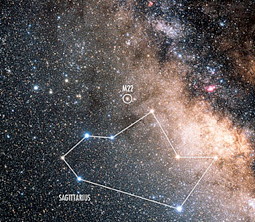Pabilsag (god)
Patron god of the city of Larak. He was the husband of the healing goddess Gula/Ninkarrak/Ninisinna. He was also identified with the god Ningirsu/Ninurta.
Functions

The constellation Sagittarius, with which Pabilsag was identified, from the European Space Agency's website on the Hubble telescope.
Pabilsag's functions are hard to grasp as he often remains colourless next to his wife, the healing goddess Gula/Ninkarrak. His original functions are also difficult to assert because he was syncretised TT with the god Ninurta early on (Black and Green 1998: 147; Richter 2004: 117). However, an Early Dynastic inscription from Lagaš already refers to Pabilsag as the "warrior of Enlil", an epithet commonly used for the god Ningirsu (Krebernik 2003-05: 162). It has been suggested that Pabilsag's functions included that of a healer god (possibly related to his wife's functions), that of a divine judge, and that of a god of war and hunting; in addition, he may have had some connections to the netherworld (Krebernik 2003-05: 167), possibly due to his syncretism with the underworld god Nergal (see below).
A Sumerian literary text describes Pabilsag's journey to the city of Nippur (ETCSL 1.7.8.). The fragmentary composition seems to narrate, among other things, the marriage between Pabilsag and Ninisinna>.
Divine Genealogy and Syncretisms
Pabilsag was considered a son of the god Enlil according to the most common tradition, making his wife, the healing goddess Ninisinna, Enlil's daughter-in-law (Richter 2004: 260-61). One instance probably describes Pabilsag as the son of the god An (Richter 2004: 261).
Pabilsag was merged with several deities, the most prominent one Ningirsu/Ninurta. The syncretism with Ningirsu/Ninurta probably took place during the Old Babylonian period (Krebernik 2003-05: 162). Pabilsag's association with the netherworld could be due to his syncretism with the underworld deity Nergal (Richter 2004: 264).
Cult Places
Pabilsag was the patron deity of the ancient city of Larak, which has not been located yet, but is possibly in the vicinity of Isin [~/images/Isin.jpg] (Richter 2004: 263). The Sumerian Kinglist (ETCSL 2.1.1) mentions Larak (sometimes spelled Larag) as one of the antediluvian TT cities. His worship is attested in texts from Ur [~/images/Ur.jpg], Lagaš [~/images/Lagash.jpg]/Girsu [~/images/Girsu.jpg], Umma [~/images/Umma.jpg], Nippur [~/images/Nippur.jpg], Babylon [~/images/Babylon.jpg] and Isin [~/images/Isin.jpg] (Krebernik 2003-05: 264-6). He likely also resided in Gula's/Ninisina's temple at Isin [~/images/Isin.jpg], the é-gal-mah ("Magnificent Palace") (George 1993: 88; Krebernik 2003-05: 166). His own temple, the é-rab-ri-ri (George 1993: 136-7), is only mentioned in cultic lamentations dating to the first millennium BCE. Krebernik (2003-05: 166) suggested that this temple was located in Isin [~/images/Isin.jpg].
Time Periods Attested
Pabilsag is first mentioned in texts dating to the Early Dynastic IIIa period, namely in god lists from Fara and Tell Abu Salabikh (Krebernik 2003-05: 161). A legal document dating to the Old Akkadian period indicates that his worship continued at least until that time (Richter 2004: 178). He also appears in a few administrative texts from the Ur III period, in which priests and offerings for him are mentioned (Krebernik 2003-05: 165-6). During the Old Babylonian period, Pabilsag seems to have been worshipped mainly in connection with his wife, the healing goddess (Richter 2004). Pabilsag is also mentioned in a Neo-Assyrian god list from Sultantepe (STT 379, ii 14) and in a late (Neo-Assyrian?) text from the city of Assur (KAR 142) (Krebernik 2003-05: 162).
Iconography
In the first millennium Pabilsag could be depicted as a high administrative official (Akkadian zazakku) (Krebernik 2003-05: 164), while by Hellenistic times he was depicted as a centaur, a mythical creature part human and part horse, sometimes with the tail of a scorpion (Green 1993-95: 256). By that era he was also identified with the constellation Sagittarius.
Name and Spellings
The meaning of Pabilsag's name is unclear. Attempts to interpret the name as "arrow-shooter" or "the elder is the leader" have been discounted on phililogical grounds (Krebernik 2003-05: 161). For a full list of spellings and possible etymologies see Krebernik 2003-05: 160-1.
- Written forms:
- Early Dynastic: dpa-bilx(GIŠ.PAP.NE)-saŋ, dpa-bìl(GIŠ.GIBIL)-saŋ, dpa-bil4(GIŠ.NE)-saŋ, dpa-bíl(GIBIL)-saŋ, dpa-bil(NE)-saŋ
- Old Akkadian/Ur III: dpa-bìl(GIŠ.GIBIL)-saŋ, dpa-bil4(GIŠ.NE)-saŋ
- Post-Ur III: dpa-bíl-saŋ, dpa-bil-saŋ, pa-bi-il-sa-ág̃, dPA
- Constellation: mul/múlPA, mul/múlPA-BIL, PA.SAG
- Normalised forms:
- Pabilsag, Pabilsaŋ
Pabilsag in Online Corpora:
- The Electronic Text Corpus of Sumerian Literature
- The Electronic Text Corpus of Sumerian Royal Inscriptions
- The Corpus of Ancient Mesopotamian Scholarship [Celestial name]
Further Reading
- Green 1993-95, "Mischwesen. B."
- Krebernik 2003-05, "Pabilsag."
- Richter 2004, Untersuchungen zu den lokalen Panthea.
Nicole Brisch
Nicole Brisch, 'Pabilsag (god)', Ancient Mesopotamian Gods and Goddesses, Oracc and the UK Higher Education Academy, 2019 [http://oracc.museum.upenn.edu/amgg/listofdeities/pabilsag/]